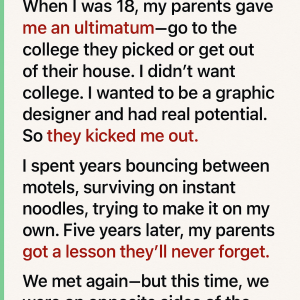There are wounds that families carry silently—absences so profound they reshape every relationship, every belief, every assumption about who we can trust. The Hoffman family knew this weight intimately. For twenty years, they lived with a hole in their lives shaped exactly like Dale Hoffman, who vanished on a freezing November evening in 1992, leaving behind nothing but unanswered questions, neighborhood speculation, and a little girl convinced her daddy simply didn’t love her enough to stay. When an old quarry finally revealed what it had been hiding in 2012, the truth that surfaced proved far darker than abandonment. This wasn’t a story about a man who walked away—it was about a betrayal so complete, so devastating, that it would obliterate everything the Hoffmans believed about the person who had spent two decades earning their trust.
The Last Goodbye
The moment lives in Emma’s memory with crystalline clarity, sharp-edged and unforgiving. November 14, 1992. She was eight, all awkward limbs and missing teeth, practically vibrating with energy in their home’s narrow hallway. Her father, Dale Hoffman, was getting ready for another long haul in his rig—what would turn out to be his last journey. At forty-two, Dale embodied working-class strength: shoulders broad enough to carry the weight of building Twin Pines Trucking from scratch, hands weathered from endless highway miles, and laugh lines etched around his eyes from years of squinting into the sun through a windshield.
“Mind your mother while I’m gone, pumpkin,” he’d said, crouching to meet her eyes. His voice carried that familiar diesel-engine rumble, though it always gentled when he spoke to her. The scar cutting across his chin—a pale reminder of a childhood bike crash—caught the light as he smiled down at her.
“You’ll make it back for the Christmas parade, right?” Emma had pressed, fingers worrying the edge of her sweater. That annual parade was sacred territory for them, a father-daughter ritual where they’d claim prime real estate on Main Street and share steaming hot chocolate while waiting for Santa’s float.
“Nothing could keep me away,” Dale promised, booping her nose with a finger that smelled like wintergreen gum and engine grease. “You and me, front row seats to the whole thing. Cross my heart.”
Those final words would echo in Emma’s mind for decades, their unintended prophecy haunting her dreams.
Dale pulled out that evening behind the wheel of his beloved 1987 Peterbilt, the truck gleaming like polished steel under the streetlights. More than transportation, it was the crown jewel of Twin Pines Trucking, the business he’d built from nothing alongside his closest friend and business partner, Carl Briggs. The engine’s familiar rumble meant safety, stability, the promise that Dad would always come home.
Except this time, that mechanical heartbeat faded into the November dark and was never heard again.
When Hope Turns to Dread
The first two days passed in that special kind of hell reserved for families of the missing—sterile police procedures wrapped around raw parental terror. Linda Hoffman, Emma’s mother, spent forty-eight hours attached to the telephone like it was life support, placing call after desperate call to truck stops, roadside diners, weigh stations along Dale’s planned route. Her voice grew more ragged with each conversation, each dead end, each apologetic “Sorry, haven’t seen him.”
Deputy Sheriff Tom Garrett appeared at their door on day three carrying the weight of bad news in his posture. Tall and lanky, still growing into his authority, he held a manila folder containing what would become the first puzzle piece in a mystery that wouldn’t be solved for two decades.
“Mrs. Hoffman,” he began, perching uncomfortably on their living room couch, “we’ve located your husband’s last confirmed position. A Texaco off Highway 287, roughly two hundred miles north. He fueled up and bought supplies around 11:47 PM on the fourteenth.”
Linda leaned forward, hope flickering behind exhausted eyes. “Did anyone talk to him? See which direction he headed?”
Garrett consulted his notes, brow creased with concentration. “The overnight clerk remembers him—said he seemed fine, just tired. But something’s odd.” He extracted a crumpled receipt from an evidence bag. “He bought two ham and cheese sandwiches and two coffees. Your husband always drove solo, correct?”
“Always,” Linda whispered. “Dale never picked up strangers, never traveled with company. It was policy—his policy.”
That receipt became the first ghost in what would develop into a haunted investigation. Two sandwiches. Two coffees. Dale Hoffman, who prided himself on his lone-wolf habits, hadn’t been alone on his final night.
Days expanded into weeks, weeks compressed into months. The investigation cooled. Search teams scoured forests and ravines, volunteers with tracking dogs and metal detectors combed every mile of highway between Cedar Falls and Dale’s last known stop. They discovered nothing—no distinctive Peterbilt, no evidence of struggle, no remains.
By spring 1993, the official search quietly wound down. By summer, the whispers started spreading.
The Poison of Speculation
Cedar Falls was the kind of small town where everyone knew everyone else’s secrets, where gossip served as currency and speculation as entertainment. Dale Hoffman’s disappearance—a successful entrepreneur, devoted family man, community pillar—created a vacuum that local imagination eagerly filled with increasingly wild theories.
The rumors started small and metastasized with each retelling. Dale had gambling problems with dangerous creditors. He was involved in an affair and ran away with his lover. He’d embezzled from his own company and escaped to Mexico ahead of prosecution. These stories circulated through coffee shops and church basements, gaining weight and legitimacy with each repetition until many accepted them as verified truth.
For Emma, these whispers were slow-acting poison. She’d catch fragments of conversations that died abruptly when adults noticed her presence. The sympathetic glances from teachers carried layers of pity that transcended simple grief—they pitied her for being left behind, for having a father who chose departure over staying to fight whatever demons he’d found.
The psychological damage ran deep. The confident, energetic child who’d bounced with excitement waiting for her father’s return gradually transformed into a withdrawn, quiet girl haunted by abandonment issues that would shadow her into adulthood. She excelled academically—partly from natural intelligence, partly from a desperate need to prove herself worthy of love—but formed few genuine friendships. Her fear that people would inevitably leave became self-fulfilling prophecy as she kept everyone at emotional distance.
Through these dark years, one constant remained: Carl Briggs. Dale’s business partner and closest friend, Carl was average height and build, with thinning brown hair and unremarkable features that made him naturally trustworthy and easy to overlook. He’d known Dale since their Army days, and together they’d transformed Twin Pines Trucking from a single beat-up truck and shared independence dream into something substantial.
After Dale’s disappearance, Carl became the family’s unofficial protector. He navigated the byzantine maze of insurance claims and legal proceedings that follow mysterious disappearances, his patience and expertise guiding Linda through processes she couldn’t have managed alone. When the insurance company finally paid out the $700,000 life insurance policy after the mandatory waiting period, Carl ensured every dollar reached the Hoffman family rather than getting tangled in legal red tape.
But his support transcended financial matters. Carl showed up for Emma’s school plays when her mother was too depressed to attend. He stood in as surrogate father at her high school graduation, walked her down the aisle at her wedding when no one else could fill that role. He remembered her birthday every single year, sent Christmas cards with heartfelt handwritten notes, never failed to tell her how proud her father would have been of who she was becoming.
“Dale was like my brother,” Carl would say whenever Emma thanked him for his continued presence. “Looking after his girls isn’t charity—it’s family duty. It’s what he would’ve done for me.”
This unwavering dedication forged an unbreakable bond between Carl and the Hoffman family. He became more than a friend or business associate—he became beloved Uncle Carl, whose presence helped fill the devastating void Dale’s absence had created. Emma grew up loving him almost as much as she’d loved her father.
The cruel irony—though Emma wouldn’t understand for twenty years—was that her love for Carl was constructed entirely on the foundation of his greatest deception.
Building a Life on Broken Ground
As Emma navigated adolescence into young adulthood, the acute agony of her father’s disappearance evolved into chronic pain that colored every aspect of her existence. She threw herself into academic achievement, earning scholarships that eventually carried her through college and graduate school. The insurance money Carl had helped secure provided financial stability, but Emma was determined to build her own success rather than depend on what she privately called “abandonment money.”
She studied psychology, drawn to understanding the human mind and perhaps hoping to decode why her father had chosen to leave. Her thesis explored the long-term psychological impact of parental abandonment on children—research that was intensely personal even if she never admitted it to professors or peers.
By her late twenties, Emma had established a thriving practice as a family therapist, specializing in helping children cope with divorce and abandonment. The irony wasn’t lost on her—healing other families while her own remained shattered, helping other children understand their parents’ choices weren’t their fault while struggling to believe that truth about her own situation.
Carl remained constant throughout these years. He attended her college graduation, beaming with pride. He showed up for her engagement party, wedding, the birth of her first child. In many ways, he’d become the father figure she needed, filling that role with such dedication and love that Emma sometimes felt guilty for wishing he were actually her father instead of just the man who stepped up when her real father stepped out.
The relationship flowed both directions. Emma genuinely loved and respected Carl, seeking his counsel on major life decisions and considering him among the most trustworthy people in her world. When she struggled with career choices, marriage challenges, or new motherhood, Carl was often her first call. His wisdom seemed born from genuine experience and authentic care, and his consistency over the years had proven his reliability in ways that made questioning his character feel almost sacrilegious.
The Quarry’s Confession
October 15, 2012. Twenty years and eleven months after Dale Hoffman vanished into darkness, construction crews began draining the abandoned Garrison Quarry as part of a new housing development. The quarry had sat unused for decades, its deep waters serving as unofficial swimming hole for teenagers and dumping ground for everything from old appliances to, rumor suggested, evidence people preferred forgotten.
The pumps worked three days straight, groaning and churning as they expelled millions of gallons of murky water that had sat undisturbed for years. As water levels dropped, the quarry’s secrets began emerging. First came expected debris—shopping carts, a refrigerator, a rusted bicycle frame. Then something that made the construction foreman reach for his radio with trembling hands.
Tilted at an impossible angle on the quarry floor, like some sleeping giant disturbed from rest, sat a 1987 Peterbilt truck.
Emma received the call at work, her secretary’s voice shaking with the weight of news she was delivering. “Mrs. Parker, Sheriff Garrett needs you at the quarry immediately. They’ve found… they’ve found your father’s truck.”
The drive passed in a blur of disbelief, hope, and terror. Emma’s hands shook on the steering wheel as possibilities raced through her mind. If they’d found the truck, maybe her father was alive. Maybe he’d been injured and suffering from amnesia. Maybe twenty years of believing he’d abandoned her were about to be revealed as terrible misunderstanding.
But the scene at the quarry told a different story. Sheriff Garrett—no longer the young deputy who’d first investigated her father’s disappearance but now a seasoned veteran with gray hair and weathered features—stood at the water’s edge watching as a crane carefully lifted the massive truck from its watery grave. The Peterbilt emerged like a ghost from another era, chrome dulled but shape unmistakable.
Emma stood beside her mother, both women clutching each other as they stared at the impossible sight. The truck remained intact, preserved by the cold, oxygen-poor environment of the quarry’s depths. Algae clung to its surfaces like a funeral shroud, but familiar details were still visible—the distinctive paint job, custom chrome accessories, even the dent in the front bumper Emma had made when she was six, learning to ride her bike and colliding with the parked truck.
Carl arrived shortly after, face ashen with shock. “My God,” he whispered, placing a comforting hand on Linda’s shoulder. “After all these years, I can’t believe it.”
The recovery operation continued through the afternoon. When they finally opened the cab door, twenty years of mystery came to an end. Dale Hoffman was there, still belted into the driver’s seat, remains skeletal but identifiable. Taped to the dashboard, miraculously preserved, was Emma’s third-grade school photo—a gap-toothed smile frozen in time, the final image of his daughter that Dale had carried into death.
But the reunion between father and daughter brought no closure. The medical examiner’s preliminary assessment revealed the truth that would shatter Emma’s world again: this was no accident. There was no evidence of mechanical failure, no indication Dale had lost control. Instead, there was a small, clean hole in the back of his skull—the unmistakable signature of close-range execution.
Dale Hoffman hadn’t abandoned his family. He’d been murdered.
Following the Thread
Sheriff Garrett approached the renewed investigation with methodical patience born from twenty years of wondering what he’d missed the first time. The quarry had preserved more than Dale’s remains—it had created a time capsule containing evidence that might have degraded or been lost under normal circumstances.
The original case file, thick with statements and dead-end leads, became Garrett’s roadmap back to 1992. He reread every witness statement, re-examined every piece of evidence, began the painstaking process of reconstructing Dale Hoffman’s final night.
The Texaco receipt remained the crucial starting point. Two sandwiches, two coffees, purchased at 11:47 PM. Dale had been with someone he knew well enough to buy dinner for, someone he trusted enough to allow into his truck. The killer hadn’t forced entry—they’d been invited.
Garrett began re-interviewing everyone from the original investigation, starting with Carl Briggs. Carl’s alibi from twenty years earlier was simple and seemingly airtight: he’d been home sick with flu on November 14, 1992. His wife, Dolores, had confirmed this during the original investigation, stating Carl had been bedridden all night with fever and couldn’t have been anywhere near Highway 287.
“I remember clearly because I was so worried,” Dolores had told investigators in 1992. “He was burning with fever, could barely get out of bed. I brought him soup and medicine all night.”
Twenty years later, Dolores repeated the same story with the conviction of someone recounting absolute truth. Carl expressed complete willingness to cooperate, his grief over his friend’s murder appearing genuine, his desire for justice seemingly sincere.
But modern investigative techniques possessed capabilities that didn’t exist in 1992. Garrett’s team began comprehensive digital reconstruction of financial records from the night Dale disappeared, using computer databases and search algorithms to examine every transaction within a fifty-mile radius of Dale’s last known location.
The process was tedious, requiring cooperation from dozens of financial institutions, gas stations, and businesses that had long since changed ownership or closed. But gradually, a digital map of financial activity began emerging, showing the movement of money—and by extension, people—through the area that night.
Detective Maria Santos, a financial forensics specialist, found the needle in the twenty-year-old haystack. Working late one Friday evening, cross-referencing credit card transactions against the timeline of Dale’s disappearance, she discovered a transaction that shouldn’t exist.
Carl Briggs. Credit card purchase. November 14, 1992, 10:15 PM. Marathon gas station on Highway 287, less than ten miles from the Texaco where Dale had made his final purchase. The transaction was for a full tank of gas and cigarettes.
Santos stared at her screen, coffee growing cold as she processed the implications. According to his alibi, Carl Briggs had been home in bed with flu, too sick to leave the house. But here was digital proof he’d not only been out of bed—he’d been on the same stretch of highway as Dale Hoffman, just ninety minutes before Dale’s final confirmed sighting.
The Crumbling Facade
When Sheriff Garrett confronted Carl with the credit card evidence, the man who’d been the Hoffman family’s pillar of strength for twenty years began to fracture. The transformation was subtle at first—a slight tremor in his hands, barely perceptible change in breathing, the way his eyes darted toward the exit before returning to meet Garrett’s gaze.
“I don’t understand,” Carl said, voice carefully controlled. “There must be some mistake. I was home sick that night. Dolores can confirm it.”
But Garrett had been a cop long enough to recognize the signs of a man whose carefully constructed lies were collapsing. He pushed harder, presenting Carl with copies of credit card statements, timestamps, incontrovertible evidence placing him in the exact location where his best friend had been murdered.
“Maybe your wife was mistaken about the timeline,” Garrett suggested. “Twenty years is a long time. Memory can be unreliable.”
Carl’s composure slipped slightly. “Dolores doesn’t make mistakes about things like that. She has excellent memory.”
“Then maybe you made a quick trip out while she was sleeping. Maybe you felt better for a few hours, decided to go for a drive. Maybe you ran into Dale by coincidence.”
“No,” Carl said, but his voice lacked conviction. “I was home all night. I never saw Dale that evening.”
As the interview continued, Garrett noticed other inconsistencies in Carl’s story. Details that had seemed reasonable twenty years earlier now appeared rehearsed, too perfect, too convenient. The flu that supposedly kept him bedridden—why weren’t there doctor’s visits or prescription records? The timeline of his illness—why could Dolores remember it so precisely after two decades when most people couldn’t recall last week’s breakfast?
Most tellingly, when Garrett asked Carl about Dale’s state of mind in the weeks before his disappearance, Carl’s answers revealed knowledge he shouldn’t possess if their relationship had been as straightforward as he claimed.
“Dale had been worried about something,” Carl admitted. “He seemed distracted, maybe paranoid. He was asking questions about business finances, about my personal life. It was straining our friendship.”
“What kind of questions?”
Carl hesitated, perhaps realizing he was revealing more than intended. “He seemed to think I was hiding something from him. He was wrong, of course, but it hurt that my best friend didn’t trust me.”
Garrett filed away these admissions while continuing to dig deeper into financial records. What he found painted a picture of a man in desperate trouble. Carl Briggs, the steady, reliable business partner who’d helped Dale build Twin Pines Trucking into success, had been living a double life.
Hidden credit card accounts revealed a pattern of gambling dating back years. Casino visits, sports betting, private poker games—Carl had been hemorrhaging money at an alarming rate. By November 1992, he owed substantial sums to people who didn’t accept late payments or payment plans. His half of the trucking company wasn’t enough to cover his debts, but Dale’s life insurance policy would be.
More damning still were Dale’s own notes, found in a lockbox investigators had missed during the original search of his home office. Dale’s meticulous record-keeping had documented his growing suspicions about his business partner. Entries from the weeks before his death painted a picture of a man who’d begun suspecting his trusted friend was embezzling from their company and might be in serious financial trouble.
“Carl asking about life insurance again,” one entry read. “Third time this month. Says it’s for business planning, but something feels off.”
“Found discrepancies in quarterly reports,” read another. “Money missing from operating account. Need to audit books without Carl knowing.”
The final entry, dated November 12, 1992—just two days before Dale’s death—was chilling in its prescience: “Carl desperate. Gambling debts? He owes someone big. Afraid he’s going to ask me to bail him out again. Need to confront him soon. Something’s not right.”
The Architecture of Betrayal
As evidence mounted, Sheriff Garrett began constructing a timeline that revealed the depth of Carl Briggs’s betrayal. The man who’d spent twenty years comforting the Hoffman family, helping them navigate grief and rebuild their lives, had been the architect of their destruction from the beginning.
The plan, as reconstructed by investigators, was both elegant and diabolical. Carl’s gambling debts had reached a critical point by late 1992. His creditors were no longer accepting promises and partial payments—they wanted their money, and they weren’t particular about collection methods. Carl faced the choice between financial ruin and finding a large sum of money quickly.
Dale’s life insurance policy represented salvation. As business partners, Carl was named beneficiary for Dale’s share of Twin Pines Trucking in the event of his death. Combined with the personal life insurance policy that would provide for Linda and Emma, Carl stood to gain control of the entire company and access to sufficient funds to pay his debts and start fresh.
But Dale was healthy, careful, showed no signs of dying from natural causes anytime soon. Moreover, Dale’s growing suspicions about the company’s finances meant Carl’s gambling problem and embezzlement would soon be discovered. He needed Dale dead, and he needed it to look like an accident or disappearance rather than murder.
The plan Carl devised exploited his intimate knowledge of Dale’s routines and personality. He knew Dale’s route schedules, preferred stops, road habits. More importantly, he knew Dale trusted him completely and would never suspect danger from his oldest friend and business partner.
On November 14, Carl likely contacted Dale at the Texaco station, probably claiming a business emergency or personal crisis requiring immediate attention. Dale, being the loyal friend he was, agreed to meet Carl at a predetermined location. He bought extra food and coffee, planning to help his friend through whatever crisis had prompted the late-night meeting.
The meeting likely occurred at a remote location between the Texaco station and the quarry. Carl probably rode as passenger in Dale’s truck, maintaining the friendship pretense until they reached an isolated spot. The execution was clinical—a single gunshot to the back of the head while Dale was distracted or looking away, probably while still seated in the driver’s seat.
Carl then drove the truck to the quarry and sent it into the water, counting on the remote location and deep water to hide evidence permanently. He walked back to his own vehicle, strategically parked nearby, and drove home to establish his alibi with Dolores, who was likely asleep and unaware of his absence.
The brilliance of Carl’s plan lay in its simplicity and his positioning as the grieving friend rather than suspect. Who would suspect the business partner working so hard to help the victim’s family? Who would question the man seemingly sacrificing his own interests to ensure Dale’s wife and daughter were cared for?
For twenty years, the plan worked perfectly. Carl used Dale’s life insurance money to pay off gambling debts and maintain the facade of respectability. He took control of Twin Pines Trucking and operated it successfully, probably driven by a combination of guilt and the need to maintain appearances. His continued support of the Hoffman family served the dual purpose of assuaging his conscience and ensuring their continued trust and gratitude.
But the plan had always contained the seeds of its own destruction. Carl’s credit card transaction on the murder night was a digital fingerprint that couldn’t be erased or explained away. In 1992, credit card records were stored on paper and filed in warehouses, making them nearly impossible to search comprehensively. By 2012, those same records had been digitized and could be searched instantly, revealing patterns and connections that would have taken months or years to discover manually.
Moreover, Carl’s continued relationship with the Hoffman family meant he’d been under observation for twenty years, even if that observation was friendly rather than suspicious. Every interaction, every statement, every expression of grief or support had been witnessed and remembered. When investigators began reexamining these interactions with knowledge that Carl was lying about his alibi, patterns emerged suggesting guilt rather than innocence.
The Moment of Truth
Sheriff Garrett decided to arrest Carl Briggs on a cold Thursday morning in March 2013, almost exactly twenty years after he’d first interviewed him as a witness in Dale Hoffman’s disappearance. The irony wasn’t lost on anyone involved—the man considered the most reliable witness in the original investigation was about to be charged with the crime itself.
Emma was present when they arrested Carl at his home, having been warned by Sheriff Garrett that the arrest was imminent. She wanted to see his face when he realized his twenty-year lie was finally over. She needed to witness the moment when the mask he’d worn for so long finally slipped away.
Carl’s reaction was everything Emma had expected and nothing like she’d imagined. When he saw the handcuffs, his carefully maintained composure cracked completely. The man who’d been a pillar of strength and reliability for two decades suddenly looked old, fragile, utterly defeated.
“I’m sorry,” he said, voice barely above a whisper as officers read him his rights. “Emma, I’m so sorry. I never meant for it to go this far. I never meant to hurt you and your mother.”
But his apology only deepened the betrayal. This wasn’t justice—it was the revelation that everything Emma had believed about love, loyalty, and family had been built on a foundation of lies. The man who’d taught her to trust again after her father’s disappearance had been the one who made that trust necessary in the first place.
“You killed my father,” Emma said, voice steady despite tears streaming down her face. “You looked me in the eye at his memorial service and comforted me while I cried for the man you murdered. You let me believe he abandoned me. You let me grow up thinking I wasn’t worth staying for.”
Carl broke down completely then, his facade finally crumbling after twenty years of careful maintenance. “I was desperate,” he sobbed. “I owed money to dangerous people. I was going to lose everything. I never meant for Dale to suffer. I made it quick. He didn’t know what was happening.”
“But I did suffer,” Emma replied. “For twenty years, I suffered. My mother suffered. We all suffered because of what you did and what you let us believe.”
Living With the Truth
Carl Briggs was ultimately convicted of first-degree murder and sentenced to life in prison without possibility of parole. The trial revealed additional details about his financial desperation and the cold calculation that had driven him to murder his best friend. His wife, Dolores, was devastated to learn her husband had lied to her for twenty years, using her as an unwitting alibi while carrying the guilt of murder.
For Emma, the conviction brought a complex mixture of justice and grief. The man who’d killed her father was finally being punished, but the man who’d been her surrogate father for twenty years was also being taken away. The relationship she’d cherished was revealed to have been built entirely on manipulation and guilt, leaving her to question every memory, every moment of affection, every piece of advice Carl had given her over the years.
The psychological impact was profound. Emma found herself needing therapy to process not just her father’s murder, but twenty years of emotional manipulation that followed. She struggled with trust issues that went beyond her original abandonment trauma, now encompassing a deep fear that anyone she loved might be hiding terrible secrets.
But perhaps the most difficult aspect was learning to separate the genuine care Carl had shown her family from the selfish motivations that drove it. Emma came to understand that Carl’s love for her had been real, even if born from guilt rather than pure affection. His support of her education, his presence at important milestones, his consistent emotional availability—these had provided genuine comfort and stability, even if their foundation was tainted.
The insurance money that had paid for Emma’s education and provided security for her family took on different meaning as well. What had once felt like “abandonment money” was revealed to be blood money, payment extracted from the life of the man who’d loved her most. Yet that money had also enabled Emma to build a successful career helping other families heal from trauma, creating some measure of redemption from tragedy.
Her mother, Linda, never truly recovered. For years she’d lived in the gray space between hope and despair, clinging to the idea that Dale might someday walk through the front door. The discovery of his body brought an end to that purgatory—but the truth behind it reopened every wound she’d ever managed to close. She withdrew from public life, rarely speaking to anyone beyond Emma and a few close friends. “He took two men from me,” she would say sometimes. “The one I loved, and the one I trusted.”
Cedar Falls, too, was shaken to its core. Carl Briggs had been one of its favorite sons—a decorated veteran, successful businessman, a man who sponsored Little League teams and donated to church fundraisers. When his guilt became public, it felt like a betrayal not just of the Hoffmans, but of the entire community.
Finding Peace
As Emma reflected on the twenty years of lies that had shaped her life, she began understanding that truth, even painful truth, was ultimately more valuable than comfortable deception. The years she’d spent believing her father had abandoned her had been difficult, but they’d also made her strong, independent, and empathetic to others facing similar struggles.
The revelation of Carl’s guilt didn’t erase the positive aspects of their relationship, but it did provide context that helped Emma understand her own resilience. She’d survived not just her father’s death, but twenty years of emotional manipulation by his killer. She’d built a successful life and healthy relationships despite carrying a wound that had been deliberately kept open by the person she’d trusted to help it heal.
In some ways, learning the truth about Carl’s crime was liberating. Emma no longer had to carry the burden of believing she’d been unworthy of her father’s love. She could finally grieve properly for a man who’d been taken from her rather than a man who’d chosen to leave. The eight-year-old girl who’d waited for her father to return from his final trip could finally understand that his failure to come home had nothing to do with her worth or his love.
For Emma, healing came slowly—not in grand gestures, but in quiet realizations. The first came when she finally stood at her father’s grave, the headstone newly set after twenty years of uncertainty. She ran her fingers over the engraved dates—1950–1992—and whispered, “I’m sorry I ever doubted you.”
The second came months later, when she found herself watching her own son play in the yard, his laughter echoing through the evening air. For the first time in years, she didn’t see ghosts in every shadow. She saw continuity—life, not loss. She understood then that her father’s love hadn’t vanished with him; it had lived on in the lessons he’d left behind, in her resilience, in her capacity to love despite everything.
Before sentencing, Emma was given the chance to speak in court. She stood before the man who’d once walked her down the aisle and addressed him not as the mentor or friend she’d known, but as the murderer he truly was.
“You didn’t just kill my father,” she said, voice clear and calm. “You killed the version of myself that trusted easily, that believed people were who they said they were. But you didn’t destroy me. You didn’t destroy us. My father’s love—his real love—was stronger than your lies. And that’s what will survive long after your name is forgotten.”
Carl didn’t look up. He wept silently, shoulders shaking under the orange jumpsuit that had replaced his familiar flannel shirt and denim jacket. It was, perhaps, the only honest emotion he’d ever shown her.
When the gavel came down and the sentence was read, Emma felt no triumph—only the quiet settling of something that had been suspended for far too long. Justice, she realized, doesn’t erase pain; it only marks the end of one kind of suffering and the beginning of another.
Years later, when her father’s story was retold on true-crime programs and podcasts, Emma chose not to participate. She’d lived the story; she didn’t need to relive it for strangers’ fascination. Instead, she wrote a letter to her son—to be opened when he turned eighteen—explaining the family secret in her own words. Not to pass on the pain, but to ensure he understood its lesson.
“Evil doesn’t always wear a stranger’s face,” she wrote. “Sometimes it looks like family, speaks with kindness, and tells you it loves you. But truth—even when it comes decades late—is the only thing that can set you free.”
The lessons Emma passed on to her children were hard-won and complex. She taught them about the importance of trust while also warning them about the dangers of blind faith. She showed them how to love openly while maintaining the wisdom to recognize when that love was being exploited. Most importantly, she helped them understand that families—real families—were built on truth rather than comfortable lies.
The twenty-year mystery of Dale Hoffman’s disappearance had finally been solved, but its resolution raised new questions about the nature of family, loyalty, and the prices people pay for the love they need. Emma’s story became not just one of a daughter finding justice for her murdered father, but of a woman learning to rebuild her understanding of trust, love, and truth in a world where the people closest to us can harbor the darkest secrets.
In the end, the quarry had surrendered more than just her father’s remains—it had given up the truth that set Emma free from twenty years of believing she’d been abandoned. The price of that freedom was the loss of another father figure, but it was a price she found herself willing to pay for the sake of finally knowing who she could trust and why.
The little girl who’d waited for her father to return could finally stop waiting. He’d never left her by choice, and his love had never wavered. That truth, purchased with twenty years of pain, was finally enough.
And with that understanding, she finally laid both her fathers to rest: the one who’d died by betrayal, and the one who’d lived by it.





